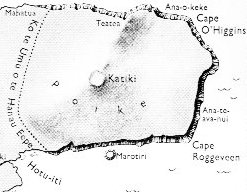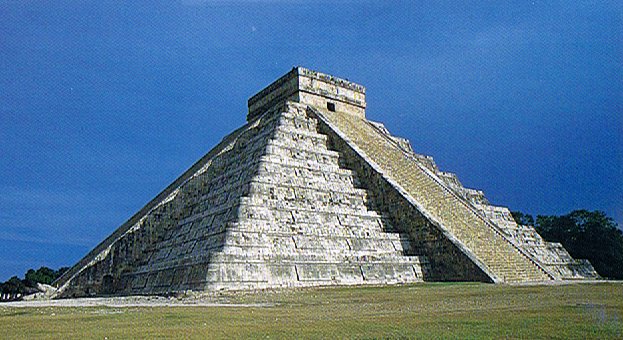4. The kuhane (dream soul) of Hau Maka (sleeping in the old land) flew over the sea to Easter Island and mapped it before the explorers arrived (and before Hotu Matua came to Anakena). She moved in the night and arrived from the west (like Moon), first noting the 3 islets outside the southwestern corner and descending on one of them: ... The dream soul of Hau Maka countinued her journey and, thanks to her mana, reached another land. She descended on one of the small islets (off) the coast. The dream soul of Hau Maka looked around and said: 'These are his three young men.' She named the three islets 'the handsome youths of Te Taanga, who are standing in the water' ...
These 3 belonged to Te Taanga another person than Hau Maka and they - I have discovered - were probably not to be 'counted' as the new land (they were standing in the 'water'). Then the dream soul of Hau Maka flew over to the mainland and continued along the southern shore to Poike in the east, naming places as she went along.
Her path then turned up to the south in a curve (pau) to in order to reach Anakena, moving past Cape O'Higgins and then westwards. A curve is a sign meaning 'close to the end'. Barthel tried to find (down on earth) all the 'stations' the kuhane named and I have worked from there to create the following list of them:
The kuhane of Hau Maka moved counterclockwise (like Sun south of the equator) to reach the place where a Sun King could live (Easter Island lies outside the tropical belt, positioned at 27º7 S 109º22 W). Anakena corresponds to the time when a new year is born (winter solstice), and the kuhane named this station Rangi Meamea, which I suppose could be a kind of wordplay for 'black sky', because a repetition normally means negation, but the name can also express how one mea (Sun) is followed by the next mea (which implies the negation of the first one). ... The dream soul came to Rangi Meamea and looked around searchingly. The dream soul spoke: 'Here at last is level land where the king can live ... This level land presumably corresponds to the flat top of a pyramid:
If we should count as a station also the 3 islets outside the southwestern corner, then Rangi Meamea would be number 24, but that cannot be right, because the birth of Tuu Maheke (and Ava Rei Pua Poki) is the first event of the new year (or new 'day') and it occurs when the clock has struck 12 (or 24). Events do not happen at points of time but between them. In my list above over the kuhane stations I have 'coloured them after the planets':
In a system of correspondences ordinal numbers define how parallel lists fit together, and I have discovered that the beginning of the kuhane list of stations probably is not with Sun but with Mercury. My colour scheme is not the only way to put in parallel colours and planets, but e.g. green should be associated with the very young buds and fresh greenery of a new world rising from the waves of the 'sea' (like Venus): "What happens after (or happened, or will happen sometime, for this myth is written in the future tense), is told in the Völuspa, but it is also amplified in Snorri's Gylfaginning (53), a tale of a strange encounter of King Gylfi with the Aesir themselves, disguised as men, who do not reveal their identity but are willing to answer questions: 'What happens when the whole world has burned up, the gods are dead, and all of mankind is gone? You have said earlier, that each human being would go on living in this or that world.' So it is, goes the answer, there are several worlds for the good and the bad. Then Gylfi asks: 'Shall any gods be alive, and shall there be something of earth and heaven?' And the answer is: 'The earth rises up from the sea again, and is green and beautiful and things grow without sowing. Vidar and Vali are alive, for neither the sea nor the flames of Surt have hurt them and they dwell on the Eddyfield, where once stood Asgard. There come also the sons of Thor, Modi and Magni, and bring along his hammer. There come also Balder and Hoder from the other world. All sit down and converse together. They rehearse their runes and talk of events of old days. Then they find in the grass the golden tablets that the Aesir once played with. Two children of men will also be found safe from the great flames of Surt. Their names, Lif and Lifthrasir, and they feed on the morning dew and from this human pair will come a great population which will fill the earth. And strange to say, the sun, before being devoured by Fenrir, will have borne a daughter, no less beautiful and going the same ways as her mother.' Then, all at once, concludes Snorri's tale wryly, a thunderous cracking was heard from all sides, and when the King looked again, he found himself on the open plain and the great hall had vanished." (Hamlet's Mill) Number 24 will according to my model turn out to be a 'Friday' (the day of Venus), and the kuhane station Oromanga is the birthplace of the new Sun King. However, this may be no more than a coincidence. |
||||||||||||||||||||||||||||||||||||||||||||||||||||||||||||||||||||||||||||||||||||||||||||||||||||||||||||||||


